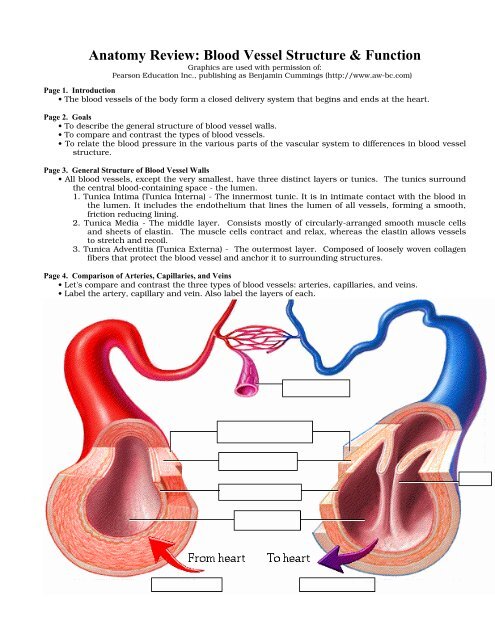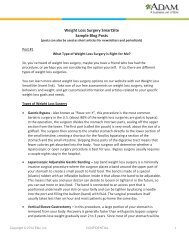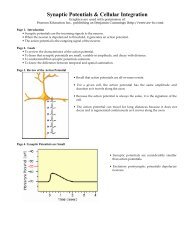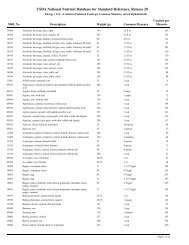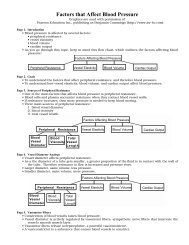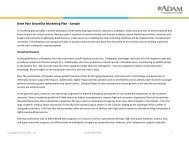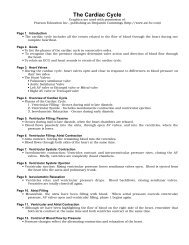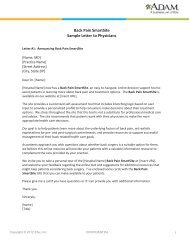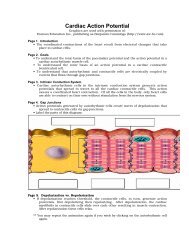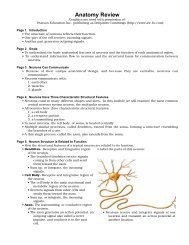Anatomy Review: Blood Vessel Structure & Function - Adam.com
Anatomy Review: Blood Vessel Structure & Function - Adam.com
Anatomy Review: Blood Vessel Structure & Function - Adam.com
You also want an ePaper? Increase the reach of your titles
YUMPU automatically turns print PDFs into web optimized ePapers that Google loves.
<strong>Anatomy</strong> <strong>Review</strong>: <strong>Blood</strong> <strong>Vessel</strong> <strong>Structure</strong> & <strong>Function</strong>Graphics are used with permission of:Pearson Education Inc., publishing as Benjamin Cummings (http://www.aw-bc.<strong>com</strong>)Page 1. Introduction• The blood vessels of the body form a closed delivery system that begins and ends at the heart.Page 2. Goals• To describe the general structure of blood vessel walls.• To <strong>com</strong>pare and contrast the types of blood vessels.• To relate the blood pressure in the various parts of the vascular system to differences in blood vesselstructure.Page 3. General <strong>Structure</strong> of <strong>Blood</strong> <strong>Vessel</strong> Walls• All blood vessels, except the very smallest, have three distinct layers or tunics. The tunics surroundthe central blood-containing space - the lumen.1. Tunica Intima (Tunica Interna) - The innermost tunic. It is in intimate contact with the blood inthe lumen. It includes the endothelium that lines the lumen of all vessels, forming a smooth,friction reducing lining.2. Tunica Media - The middle layer. Consists mostly of circularly-arranged smooth muscle cellsand sheets of elastin. The muscle cells contract and relax, whereas the elastin allows vesselsto stretch and recoil.3. Tunica Adventitia (Tunica Externa) - The outermost layer. Composed of loosely woven collagenfibers that protect the blood vessel and anchor it to surrounding structures.Page 4. Comparison of Arteries, Capillaries, and Veins• Let's <strong>com</strong>pare and contrast the three types of blood vessels: arteries, capillaries, and veins.• Label the artery, capillary and vein. Also label the layers of each.
• Arteries are vessels that transport blood away from the heart. Because they are exposed to thehighest pressures of any vessels, they have the thickest tunica media. The elastin allows them tostretch and recoil and the smooth muscle allows them to constrict and dilate.• Capillaries are the smallest vessels, the link between arteries and veins in the pathway of blood.Capillary walls consist of just a thin tunica intima, making them ideally suited for their role: theexchange of materials between the blood and the interstitial fluid.• Veins are farthest from the heart so they experience the least pressure. Their walls are thinner thanarterial walls and their lumens are larger, allowing them to ac<strong>com</strong>modate a large volume of blood.The tunica adventitia is the heaviest wall layer in veins.Page 5. Cross-Section of Artery and Vein• When you <strong>com</strong>pare an artery and a vein side by side, you observe a thick tunica media in the arteryand thin walls in the vein.Page 6. Systemic Pathway of <strong>Blood</strong> Through <strong>Vessel</strong>s• This graphic will remind you that in the systemic circulation blood travels from the heart to elasticarteries, muscular arteries, arterioles, capillaries, venules, veins, then back to the heartPage 7. Three Groups of Arteries• In terms of relative size and function, arteries can be divided into three groups:1. Elastic Arteries2. Muscular Arteries3. ArteriolesPage 8. Elastic Arteries (Aorta and Branches)• Elastic arteries are closest to the heart and experience the greatest pressure as the heart forces bloodinto them. They have the greatest amount of elastin, enabling them to expand. When the heartrelaxes, the recoil propels blood onward.• A cross section reveals abundant elastin, which can be seen as wavy fibers in the thick tunica media.Page 9. <strong>Blood</strong> Pressure in Aorta• The graph shows blood pressure variation in the various vessels of the systemic circulation. Notethat the aorta experiences the widest variation in pressure of any vessel type. Its thick tunicamedia with elastin allows it to stretch and recoil to ac<strong>com</strong>modate this pressure change as the heartpumps blood into it and then relaxes.Page 10. Muscular Arteries• In the elastic artery, elastin forms most of the wall of the tunica media. In the muscular artery, thetunica media is <strong>com</strong>posed mainly of smooth muscle.• Muscular arteries deliver blood to specific body organs.• They have relatively more smooth muscle and less elastin than elastic arteries in the tunica media.This enables them to actively constrict and relax.• Vasomotor fibers of the sympathetic nervous system regulate the activity of the smooth muscle inmuscular arteries. Depending on the needs of the body, the vasomotor fibers can causevasoconstriction (reduction in lumen diameter due to smooth muscle contraction) or vasodilation(widening of the lumen diameter due to smooth muscle relaxation).• Small changes in blood vessel diameter greatly influence blood flow and blood pressure, making themuscular arteries crucial in regulating circulatory dynamics.• When sympathetic nerves to the smooth muscle of muscular arteries fire, vasoconstriction occurswhich narrows the lumen of the artery. Lack of sympathetic stimulation causes vasodilation whichwidens the lumen of the artery.Page 11. <strong>Blood</strong> Pressure in Muscular Arteries• In muscular arteries, the pressure begins to decline.Page 12. Arterioles• Arterioles are the smallest arteries.• The larger arterioles have all three layers, but their tunica media is mainly smooth musclePage 13. Enlargement of Arterioles• Feeder arterioles bring blood directly to capillary beds. These smaller arterioles consist only ofsmooth muscle cells surrounding tunica intima.• A widened feeder arteriole will allow blood flow to a capillary bed, whereas when the feeder arteriolenarrows, less blood will flow to a capillary bed.
Page 14. <strong>Blood</strong> Pressure in Arterioles• The steepest drop in blood pressure occurs in arterioles.• Arterioles offer the greatest resistance to blood flow.• <strong>Blood</strong> flow no longer pulses by the time it gets through the arterioles.Page 15. <strong>Review</strong>: Three Groups of Arteries• <strong>Blood</strong> vessel function follows blood vessel structure. The more elastic tissue in an artery, the greaterits ability to expand and recoil (pulsate). Elastic arteries, such as the aorta, have the most elastinso they are able to expand and recoil dramatically. Muscular arteries have less elastic tissue, sothey have a reduced ability to expand and recoil. Arterioles have virtually no elastin so thepulsation smooths out.Page 16. Capillaries• Capillaries consist of only a thin tunica intima or endothelium.• Most capillaries are arranged in capillary beds.• Thinness allows exchange of materials between blood and tissues.Page 17. Capillary Beds• Label the following in this diagram:feeder arteriole, shunt, true capillaries, precapillary sphincter, drainage venule, capillary bed,tissue cells• <strong>Blood</strong> flow regulation occurs at the capillary beds. The feeder arteriole brings blood to the capillarybed. The shunt is a short vessel that directly connects the feeder arteriole and the drainage venuleat the opposite end of the bed. Exchange of materials take place between the tissue cells and theblood in the true capillaries. The precapillary sphincter is a cuff of smooth muscle fibers thatsurround the root of each true capillary, acting as a valve to regulate the flow of blood into the truecapillaries.
PREMIUMFull Time Students & Dependents RatesAnnual SpringStudent Only $956 $695Spouse Only $2,275 $1,600Child (ren) $1,635 $1,160Part Time Students 6 Credits or more & Dependents RatesAnnual SpringStudent Only $1,156 $798Spouse Only $2,777 $1,932Each Child $1,985 $1,401ENROLLMENTThe premium and enrollment for the Annual coverage must be submitted to the Plan Administrator no later than October 17, 2012.The next enrollment period will be for the Spring semester for which coverage will be effective at 12:01 a.m. on January 1, 2013 andterminate at 12:01 on September 1, 2013. The premium and enrollment form for the Spring semester should be submitted to the PlanAdministrator no later than February 15, 2013.LATE ENROLLMENTStudents will be able to enroll after the enrollment deadline if they lose coverage under their parent’s plan or employer plan. Thestudent will have to enroll within 63 days in order to avoid a break in coverage (see Pre-existing Condition Limitation). The InsuredStudent will be covered from the date after the application and premium are received by the Plan Administrator. Premiums will notbe pro-rated.IDENTIFICATION CARDSIdentification Cards will be mailed to John Boyle, Executive Director at the FSA office. A temporary identification card can beprinted at www.ajfusa.<strong>com</strong>/students. Please retain this card in a safe place. No other card will be issued to insured students.Identification cards for covered dependents will be provided by the Plan Administrator, The Allen J. Flood Companies, Inc. uponreceipt of the <strong>com</strong>pleted enrollment form and the appropriate premium.PREMIUM REFUND POLICYCoverage for a Covered Student entering the Armed Forces of any country will terminate as of the date of such entry. Those InsuredStudents withdrawing from the school to enter military service will be entitled to a pro-rata refund of premium upon written request.Premium received by the Company is fully earned upon receipt. No other requests for a refund of premium will be considered.DEFINITIONSCoinsurance means the percentage amount of Covered Expenses for which the Covered Person is responsible for any medical serviceor supply. The Coinsurance is shown in the Schedule. We will pay the remaining amount of Covered Expenses, subject to themaximum amount for specific services and the maximum benefit for all services.Complications of pregnancy means:a. Conditions whose diagnosis is distinct from but adversely affected or caused by pregnancy and which require a Hospital Stay(when pregnancy is not terminated). Such conditions include, but are not limited to, acute nephritis; nephrosis; cardiacde<strong>com</strong>pensation; missed abortion; hyperemesis gravidarum; pre-eclampsia; and similar conditions of <strong>com</strong>parable severity; orb. Non-elective cesarean section; therapeutic abortion; ectopic pregnancy which is terminated; and spontaneous termination of apregnancy during a period of gestation when a viable birth is not possible.3
3. (Page 3.) What is the tunica intima <strong>com</strong>posed of?4. (Page 3.) What is the function of endothelium?5. (Page 3.) What two structures is the tunica media <strong>com</strong>posed of? What is the purpose of each?6. (Page 3.) What is the tunica adventitia <strong>com</strong>posed of? What is its function?7. (Page 4.) Tell if the following are characteristic of arteries, capillaries or veins:a. Presence of smooth muscle allows them to constrict and dilate.b. Lumens are largest.c. Have the thickest tunica media.d. Are able to ac<strong>com</strong>modate a large volume of blood.e. Exposed to the highest pressures of any vessels.f. The link between arteries and veins in the pathway of blood.g. Experience the least pressure.h. The smallest vessels.i. <strong>Vessel</strong>s that transport blood away from the heart.j. The tunica adventitia is the heaviest wall layer.k. Presence of elastin allows them to stretch and recoil.l. Walls consist of just a thin tunica intima.m. Role: the exchange of materials between the blood and the interstitial fluid.8. (Page 7.) What are the three types of arteries classified by relative size and function? List from largestto smallest.9. (Page 8.) What layer of elastic arteries allows them to stretch and recoil?10. (Page 8.) What is the aorta?11. (Page 8-10.) Tell if the following are characteristic of elastic arteries or muscular arteries:a. Have the greatest amount of elastin, enabling them to expand when blood is forced into them.b. More smooth muscle and less elastin enables them to actively constrict and relax.c. Deliver blood to specific body organs.d. Closest to the heart.e. When the heart relaxes, they recoil.f. The tunica media is <strong>com</strong>posed mainly of smooth muscle.g. Vasomotor fibers of the sympathetic nervous system regulate the size of the lumen.h. Experience the greatest pressure.12. (Page 10.) Define vasodilation and vasoconstriction.13. (Page 10.) What causes vasoconstriction?14. (Page 13.) What are the smaller arterioles that allow blood to flow to capillary beds called?15. (Page 12,13.) Contrast the difference in the layers of a large arteriole <strong>com</strong>pared to a smaller arteriole.16. (Page 14.) Does the blood pulsate in arterioles?17. (Page 14.) Which of the three types of arteries offers the greatest resistance to blood flow?18. (Page 16.) What are capillaries made of? How does that affect their function?19. (Page 17.) Match the following to their function or characteristic:1. feeder arteriolea. exchange of materials take place here2. shuntb. short vessel that directly connects the feeder3. true capillariesarteriole and the drainage venule4. precapillary sphincterc. accepts the blood <strong>com</strong>ing from the true5. drainage venulecapillariesd. acts as a valve to regulate the flow of bloodinto the true capillariese. brings blood to the capillary bed
20. (Page 18.) What happens to blood flow through a capillary bed when precapillary sphincters constrict?21. (Page 19.) What would happen if blood pressures were high in the capillaries?22. (Page 20.) What layers are found on larger venules?23. (Page 21.) What layers are found on smaller venules?24. (Page 23.) How does the structure of veins differ from arteries?25. (Page 23.) What is the heaviest wall layer in veins?26. (Page 24.) List the three factors which assist in returning blood to the heart.27. (Page 25.) What is the structure and function of venous valves?28. (Page 25.) Where are venous valves the most abundant?29. (Page 26). How does the muscular pump work?30. (Page 27.) Explain how the respiratory pump works.31. (Pages 9, 11, 14) Match the artery type to its characteristic blood pressure:1. Aorta & other elastic arteriesa. The steepest drop in blood pressure occurs2. Muscular arterieshere.3. Arteriolesb. The pressure begins to declinec. Experiences the greatest pressure.


